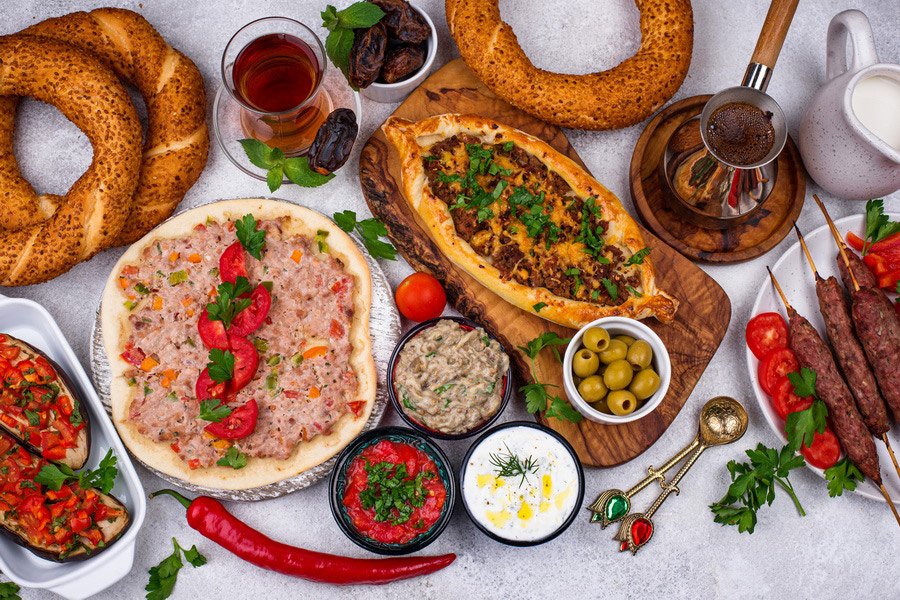
The Turkish cuisine is rich, varied, and deeply rooted in centuries of cultural exchange. The quintessential food in Turkey is a savoury kebab. Yet the Turkish restaurant menu also offers delicious mezes, aromatic pilafs, flaky börek, and indulgent sweets like baklava and künefe.
This culinary diversity is no coincidence. The evolution of Turkish cuisine has been attributed to the legacy of Central Asian nomads, the sophistication of the Seljuks, and the opulence of the Ottoman Empire. Each region of modern-day Turkey has cultivated its unique dishes, influenced by local ingredients, climate, and customs. This is the olive oil-based fare of the Aegean coast and the spicy delicacies of Southeastern Anatolia. And Turkish food continues to reflect a dynamic blend of history, geography, and hospitality.
History of Turkish Cuisine
The origins of Turkish cuisine can be traced back to the Central Asian period when Turks migrated to Anatolia before the year 1040. Meat (horse and mutton), wheat, and fermented dairy products were always the primary components of their daily diet. Later, their culinary culture evolved after they settled in the fertile Anatolian lands and incorporated vegetables and spices. In parallel, Turkish cuisine began to reflect Islamic dietary principles adopted by the population, such as the prohibition of pork and the preference for halal slaughter. This evolution further influenced the foundation of modern Turkish food culture.
Tutmaç– The Oldest Traditional Dish in Turkey
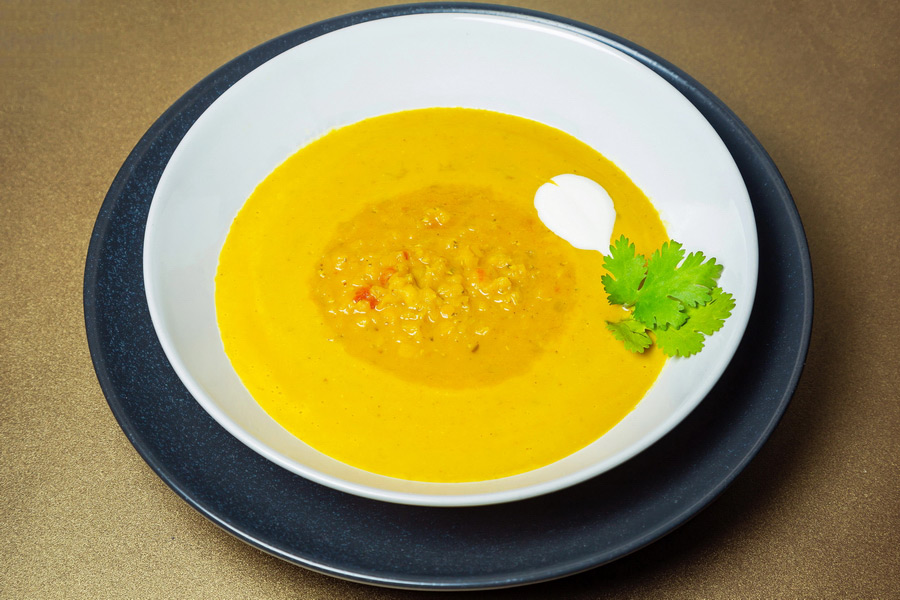
Although Turkey is often associated with kebabs, the döner kebab, commonly known as such, did not appear until the 19th century. Determining the most ancient cuisine in Turkey is challenging, but some folk tales refer to tutmac, a soup (tutmaç çorbası) made from noodles and green lentils that has survived to the present day. According to some sources, this stew derives from the Oghuz Turks in Central Asia, who subsequently altered the cooking traditions of the Anatolian Seljuks and Ottoman palaces. The tutmaç recipe varies by region.
Today's Turkish cuisine can be divided into the following regions: Eastern Anatolia, Southeastern Anatolia, Central Anatolia, Black Sea, Thrace and Marmara, the Aegean, and the Mediterranean.
What is the Most Popular Turkish Food?
According to 2024 data from Yemeksepeti, Turkey’s leading food delivery platform, the most cherished Turkish food is chicken döner kebab. This beloved street food even surpassed international dishes like burgers and pizza.
Other top-ranked dishes include:
- Lahmacun – crispy meat-topped flatbread.
- Çiğ köfte - spiced bulgur patties, traditionally made with meat but now often vegetarian.
Try this Turkish cuisine recipe at home: Chicken Döner Kebab (Serves 4)
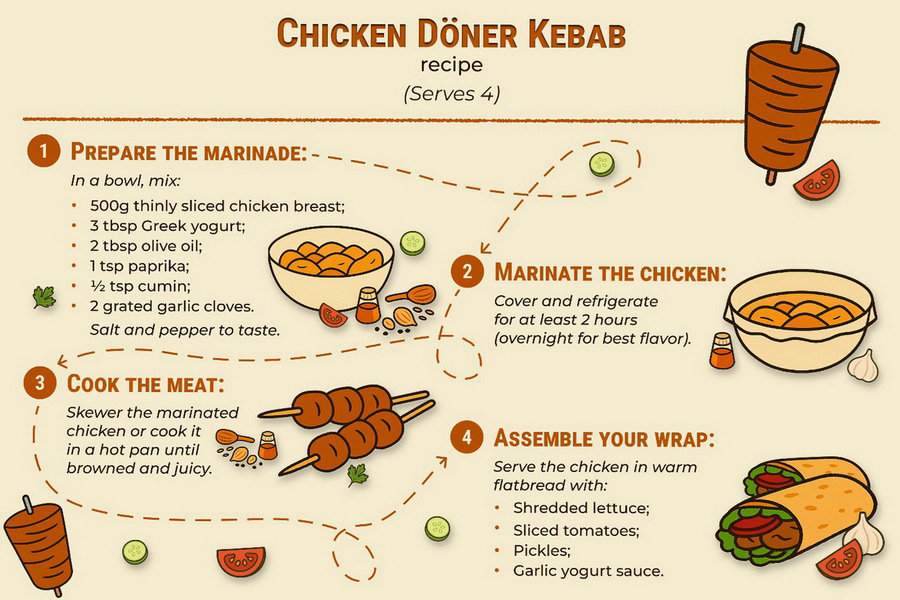
For more delicious staples, explore our list of must-try Turkish dishes.
Turkish Ottoman-Inspired Thrace and Marmara Cuisine
The Marmara region is Turkey's historical, economic, and cultural nexus. As the gateway between Europe and Asia, its cuisine synthesises Ottoman, Balkan, Caucasian, and Black Sea culinary practices, resulting in various techniques and ingredients. The hallmark of the region lies in an amalgam of Ottoman-inspired dishes alongside street grab-and-go items and multicultural meze traditions, all underpinned by access to premium local produce (e.g., sunflower oil from Thrace, dairy from Bursa, and seafood from the Sea of Marmara).
Istanbul, the heart of the Marmara and former capital of empires, played a central role in framing modern Turkish cuisine. Many recipes were refined in the imperial kitchens of Topkapı Palace, where cooks brought their regional specialities and transformed them into Ottoman cuisine.
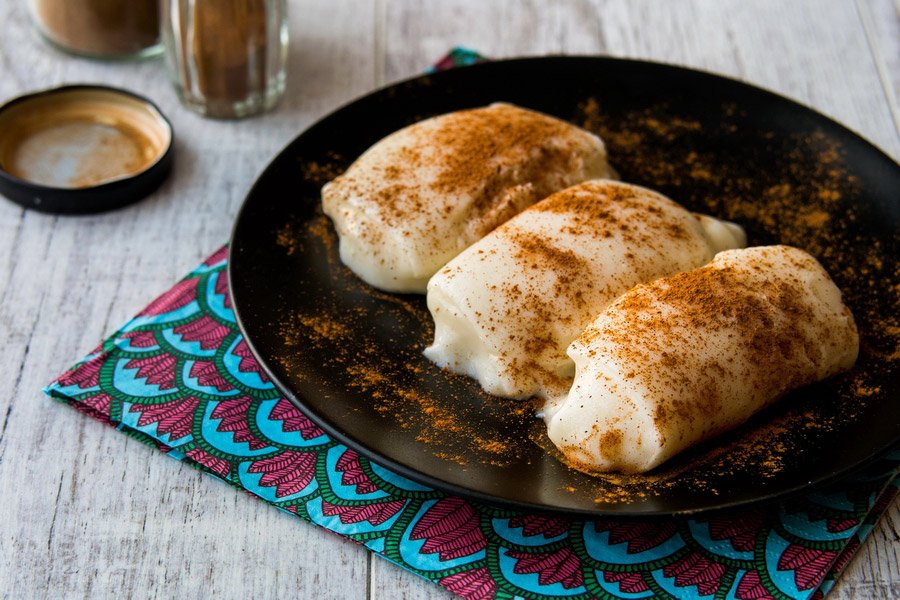
When exploring Istanbul, among must-try eats are İstanbul pilavı (rice with currants, pine nuts, and liver), çılbır (poached eggs in garlicky yoghurt with paprika butter), and tavuk göğsü (chicken breast pudding), an Ottoman dessert.
Istanbul’s meyhanes (traditional restaurants) elevated meze to an art form, featuring beyaz peynir (white cheese), lakerda (cured bonito fish), and midye dolma (stuffed mussels), a tradition ingrained in Byzantine restaurants.
A global trade hub for centuries, it has provided products such as spices, coffee, and legumes, now staples in regional cuisine. Istanbul’s Mısır Çarşısıı (Spice Bazaar, or Egyptian Bazaar) is a historic epicentre for spices and rare ingredients.
Rapid urbanisation gave rise to emblematic fast food: döner kebab (vertical rotisserie meat), balık ekmek (grilled fish sandwiches along the Bosphorus), and simit (sesame-crusted bread rings).
In Edirne, once the capital of the Ottoman Empire before Istanbul, the traditional cuisine leans toward Balkan-style meat meals. Sought-after items include Edirne ciğeri (thin slices of liver dusted in flour and fried crisp), mamzana (a salad of roasted aubergines, tomatoes, and parsley), and badem ezmesi (marzipan-like almond paste).
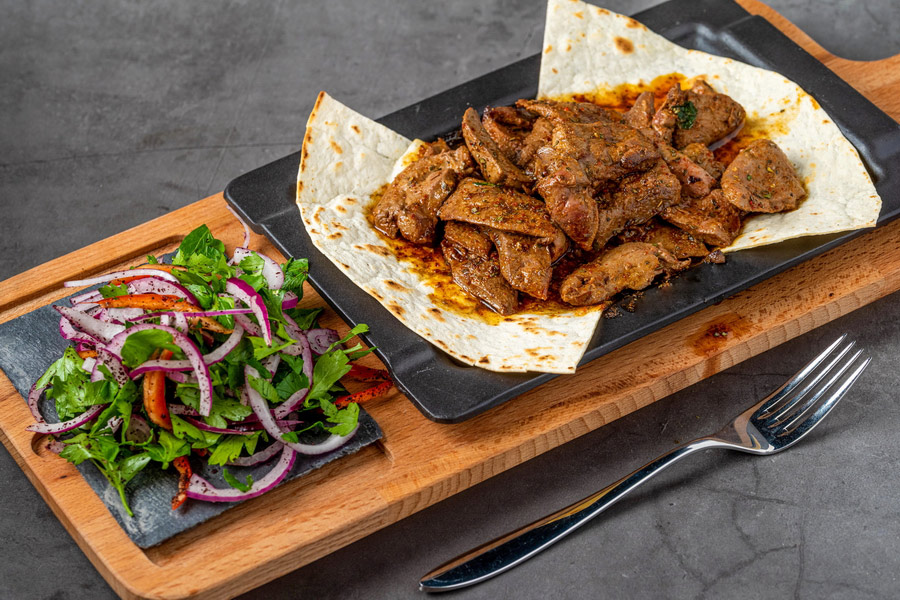
Bursa is the birthplace of Iskender kebabı and one of Turkey’s most iconic gourmet cities. It consists of döner meat over pita bread, drenched in tomato sauce, melted sheep butter, and yoghurt. Other beloved regional staples are kestane şekeri (marron glacé/candied chestnuts from Mount Uludağ), kemalpaşa tatlısı (a syrup-soaked cheese dessert), and Bursa cantık pidesi (a round pastry that can be filled with meat, cheese, or vegetables).
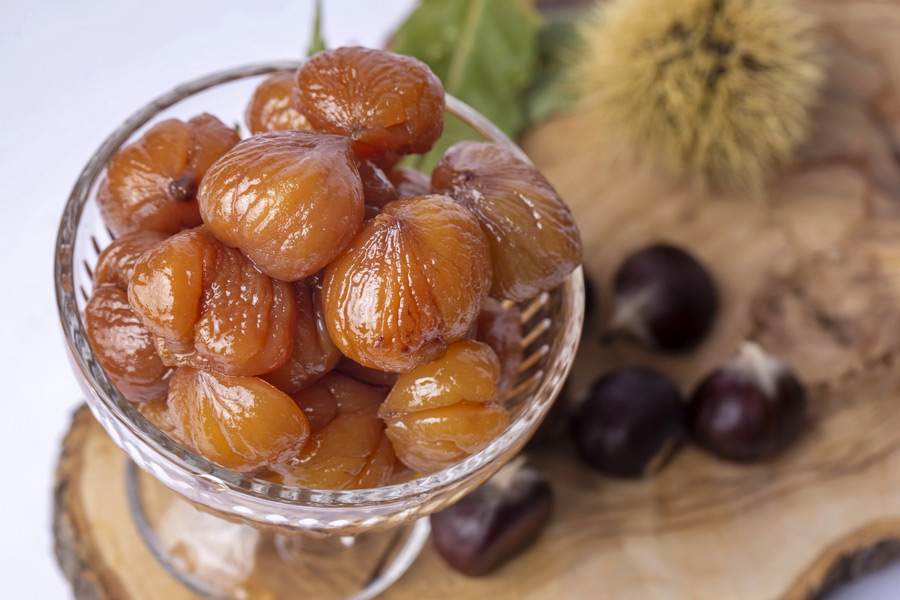
Turkish Aegean Cuisine with Olive Oil Dishes
Turkish cuisine of the Aegean region emphasises vegetables cooked in olive oil (zeytinyağlılar), wild herbs, and fresh-from-the-sea products. The prevailing trend is a vegetable-centric, seasonal approach where high-quality local produce constitutes the core of dishes, often served at room temperature.
Centuries of shared history have left a lasting mark, particularly evident in İzmir (Smyrna) and its surrounding areas. Unusual expressions, such as artichoke hearts with peas and specific preparations of vegetables in olive oil, fish, and mezes containing dairy, prove this heritage.
The gorgeous Aegean coastline, with its deep blue waters and picturesque harbours (especially in Bodrum, Göcek, and Kuşadası), is a premier destination for gullet cruises and luxury yachting. This has fostered a growing gastronomy tourism industry where visitors directly experience local markets, seaside meyhanes (traditional restaurants), and restaurants specialising in regional produce and seafood.
As the pulsing capital of the Aegean, İzmir is famed for its street food, such as boyoz (flaky pastry often with spinach/cheese), kumru (grilled sandwich with sucuk (a type of sausage) or pastirma (cured beef) along with cheese), İzmir köfte (herbed meatballs in tomato sauce), and exceptional seaweed mezes like deniz börülcesi (samphire salad). Its historic Agora market is a culinary landmark.
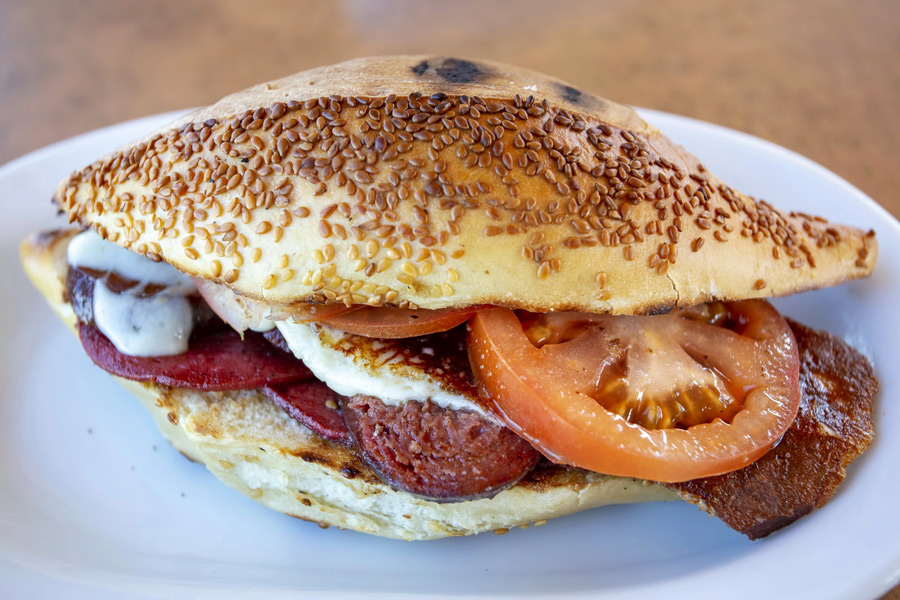
The upscale Bodrum peninsula delivers a traditional Aegean diet and coastal sophistication. These are Bodrum mantisi (smaller, dumplings served with sauce), octopus, levrek (sea bass) in a paper, and desserts incorporating local almonds and sakızlı muhallebi (mastic pudding). Fresh fish restaurants line its coves.

A tranquil yachting haven, Göcek focuses on ultra-fresh, high-quality sea delicacies. The highlights include grilled fish, ahtapot salatası (octopus salad), and classic Aegean mezes like Zeytinyağlı enginar (artichoke hearts in olive oil) and girit ezmesi (spicy cheese/walnut dip), often enjoyed directly on the waterfront. Menu-friendly favourites are also stuffed courgette flowers, sea bream grilled with rosemary, and aubergine salads.
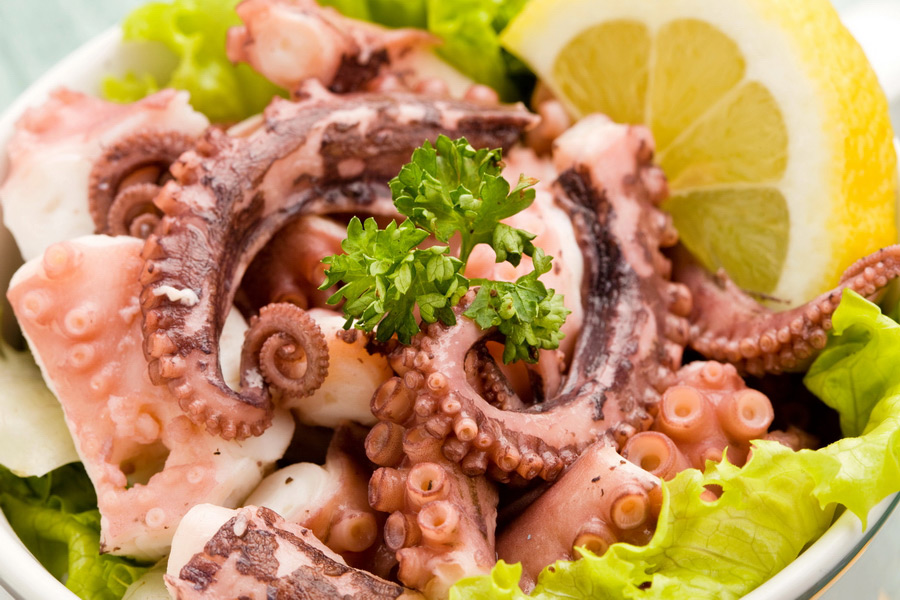
Signature dishes in Manisa are Manisa kebabı (slow-cooked meat wrapped in pita bread) and mesir macunu (a historic, spiced paste of over 40 herbs), initially made as a medicinal tonic in Ottoman times. It has also been enjoyed as a sweet treat and is associated with a festival in Manisa. Its cuisine bridges the Aegean coast and inland gastronomic cultures.
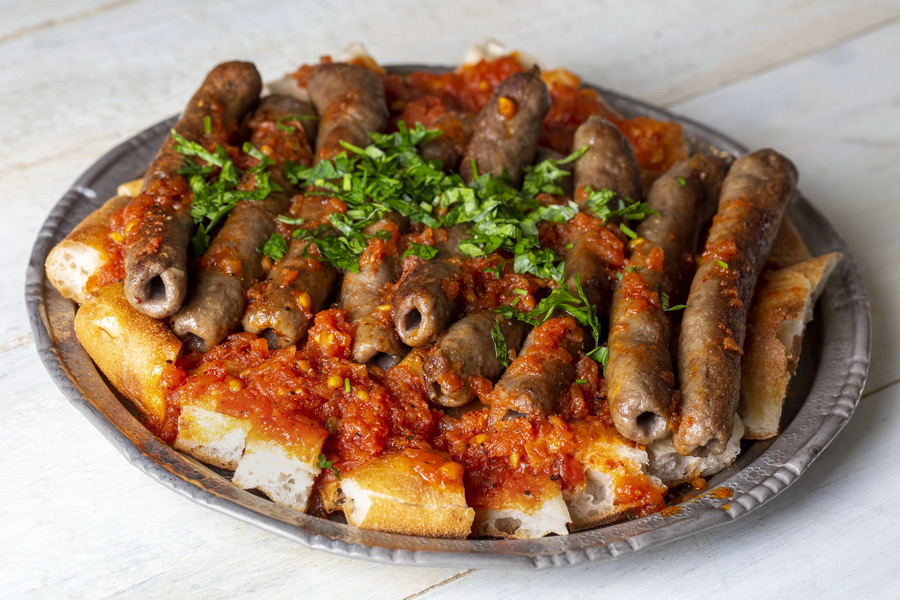
A major cruise port, Kuşadası, excels in çipura (sea bream) and Aegean mezes. Highlights involve midye dolma (stuffed mussels), shrimp casseroles, and fava bean puree topped with dill and lemon.
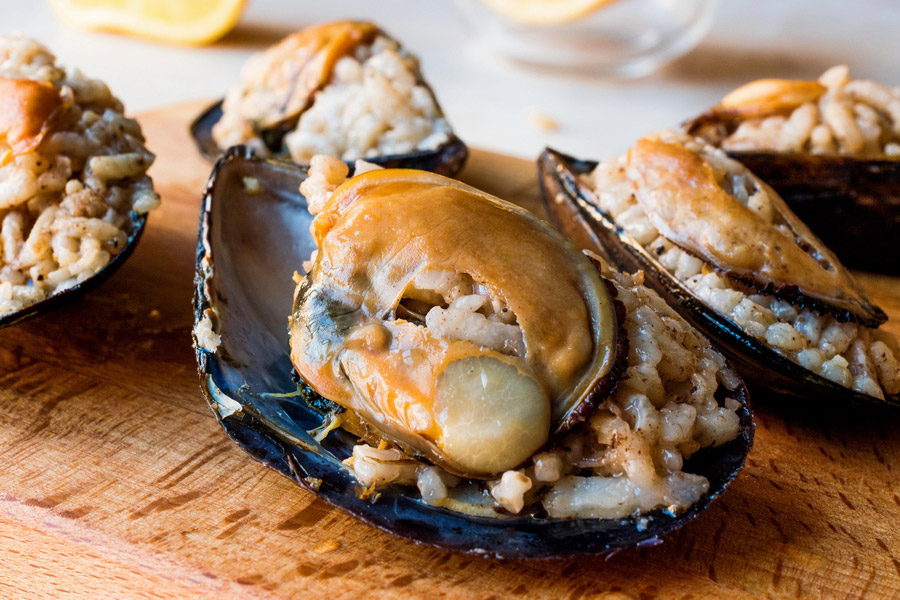
An inland hub, Aydın, is famous for Turkey’s fig production (Aydın inciri). Aydın’s cuisine showcases robust olive oil choices - kırlı kızartması (roasted vegetables), börülce (cowpea salad) and kabak çiçeği dolması (stuffed squash blossoms). It supplies high-quality olive oil and produce to the coastal towns.
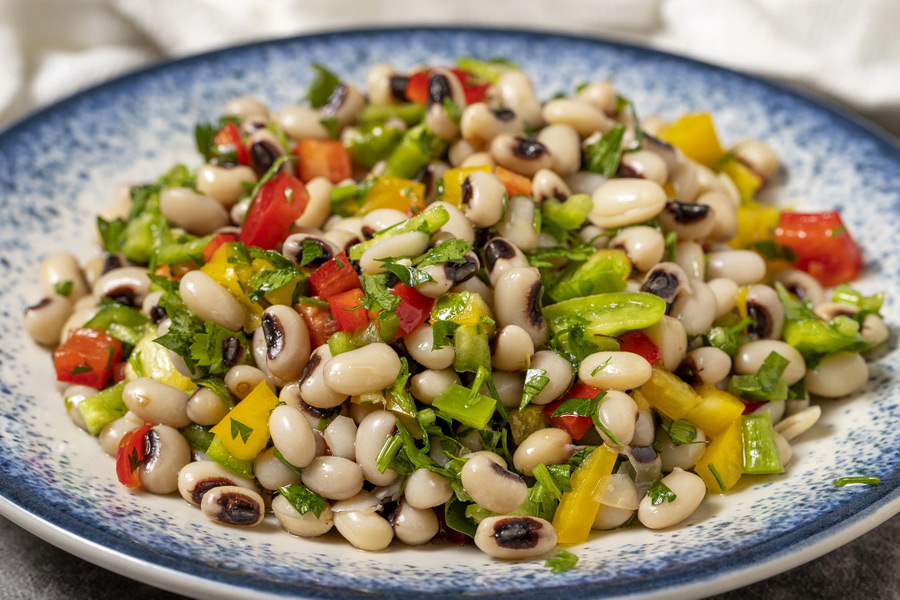
Coastal Turkish Cuisine in the Mediterranean
Mediterranean Turkey has exciting cuisine containing fresh vegetables, olive oil, maritime food, and fragrant herbs. Thanks to its mild climate, the dietary options here are typically lighter and more focused on vegetables than those found elsewhere in Turkey, yet equally flavourful. Grilled fish, fresh mezes, citrus fruits, and olive-rich stews are staples.
A cornerstone of this culinary tradition is its emphasis on seasonality and simplicity, which is demonstrated by the use of a few high-quality ingredients and the inherent freshness of local produce. One interesting fact is that the Mediterranean coast of Turkey shares many parallels with Greek and Levantine cuisine, owing to centuries of trade and cultural exchange. The area is also a sought-after destination for Blue Cruises and yachting holidays. These often cover stops at charming harbours and seaside villages celebrated for their coastal cooking.
Here's what to try in each city along the coast.
Antalya, with its thriving bazaars and citrus groves, stands out for its tahinli piyaz, a white bean salad enriched with tahini and vinegar, very different from the more common Turkish version. Hülüklü çorba (Huluklu soup), a regional dish that combines meat and chickpeas, is also emblematic.
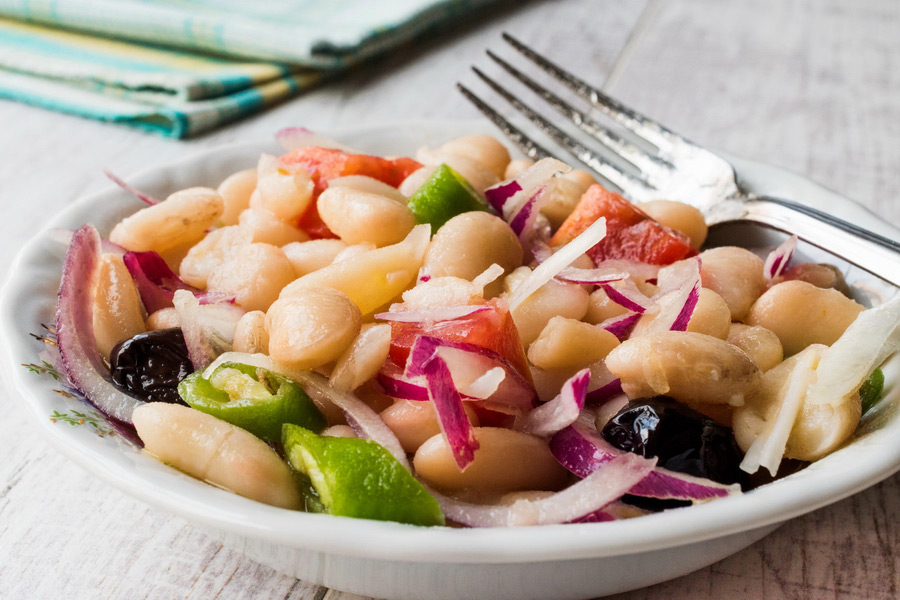
Marmaris offers plenty of grilled fish, mezes, and zeytinyağlı (vegetables cooked in olive oil). Must-try specialities are the local stuffed squash blossoms and octopus salad, served at seaside restaurants.
While slightly inland, Adana adds to the region’s multifarious tastes with bold and spicy flavours. Adana kebabı is crafted from hand-minced lamb seasoned with chilli flakes and grilled on skewers. It is traditionally accompanied by şalgam (fermented purple carrot beverage) and meze plates.
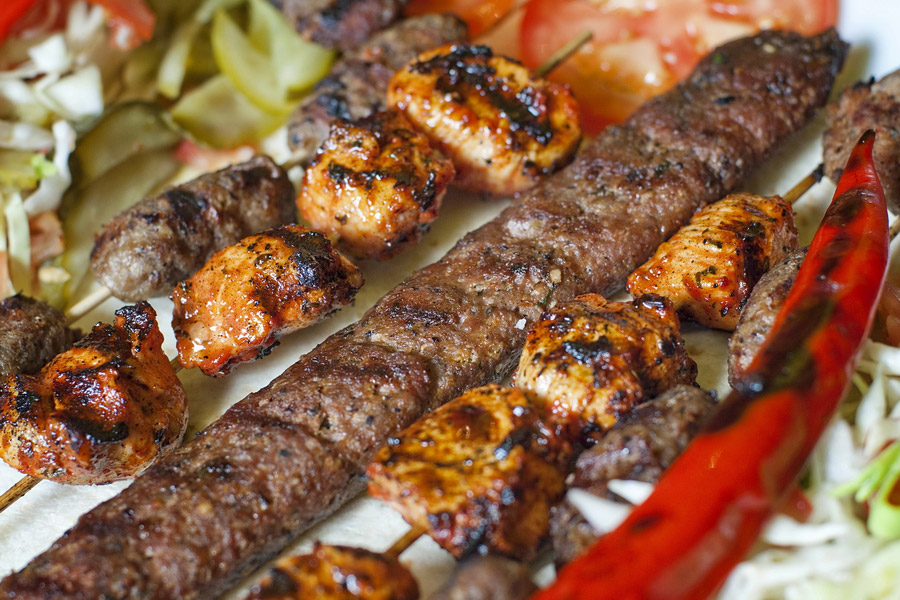
The city of Alanya presents a fusion of Mediterranean and Anatolian culinary traditions. Key dishes consist of kulu köfte (small meatballs served with vegetables) and yayla çorba, a mint-scented yoghurt soup. Alanya also boasts fast-food takeaway for a quick bite near its marina.
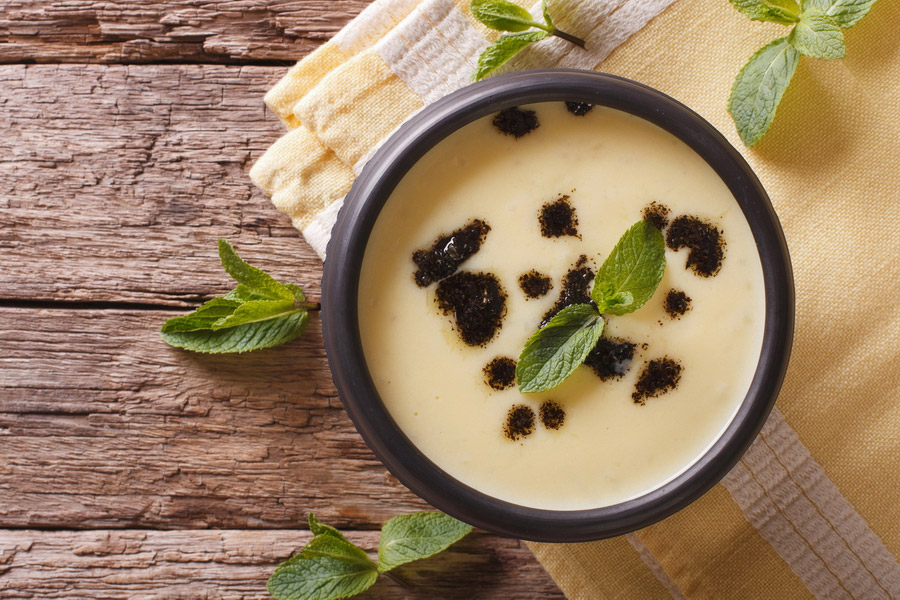
Mersin is a major port city and the birthplace of tantuni. Thinly sliced beef or lamb is quickly sautéed in cottonseed oil and wrapped in lavash. Another local delicacy is cezerye, a chewy carrot-based dessert made with walnuts, hazelnuts, or pistachios, shredded coconut, and sugar.
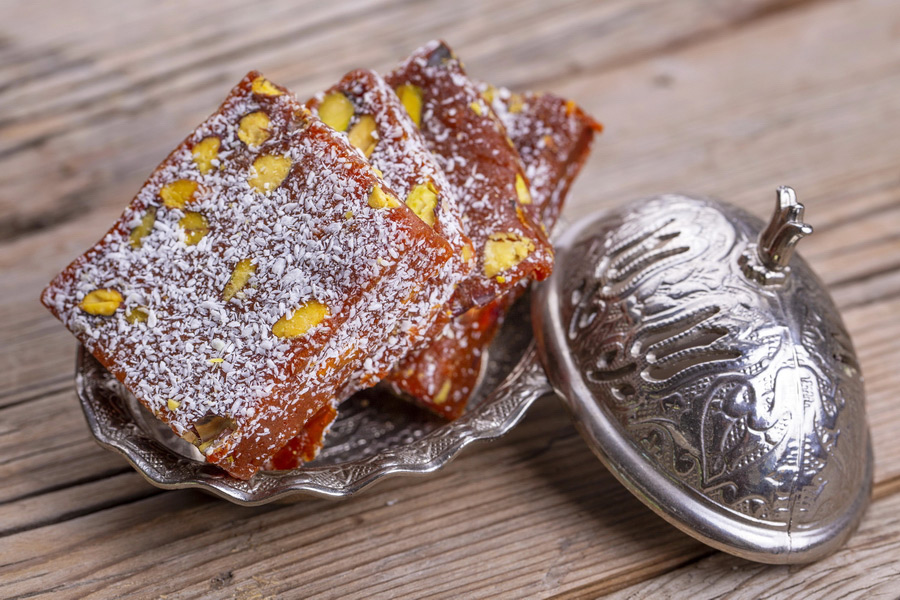
Kaş is a picturesque town that appeals to yacht enthusiasts and divers. Its organic cuisine encompasses grilled calamari, aubergine mezes with yoghurt, and domatesli bulgur pilavi (bulgur pilaf in the tomato sauce).
Central Anatolian Cuisine with Meat and Dough Specialities
Central Anatolian cuisine is a study in contrasts. Here, rustic village techniques (fermentation, communal ovens) coexist with Ottoman opulence (slow-cooked meats, intricate dumplings). Unlike coastal regions, its flavours prioritise depth over brightness – smoky tandır lamb, earthy bulgur pilafs, and tangy pickles. The region’s significance as a Silk Road hub is reflected in Kayseri’s pastırma and the traditional dishes of Konya.
In Ankara, the capital of Turkey, traditional treats like Ankara tava (lamb stewed with tomatoes, garlic, paprika, and orzo, cooked in a copper pan) and beypazarı kurusu (a crunchy, long-lasting biscuit) echo a nomadic genesis and urban refinement.
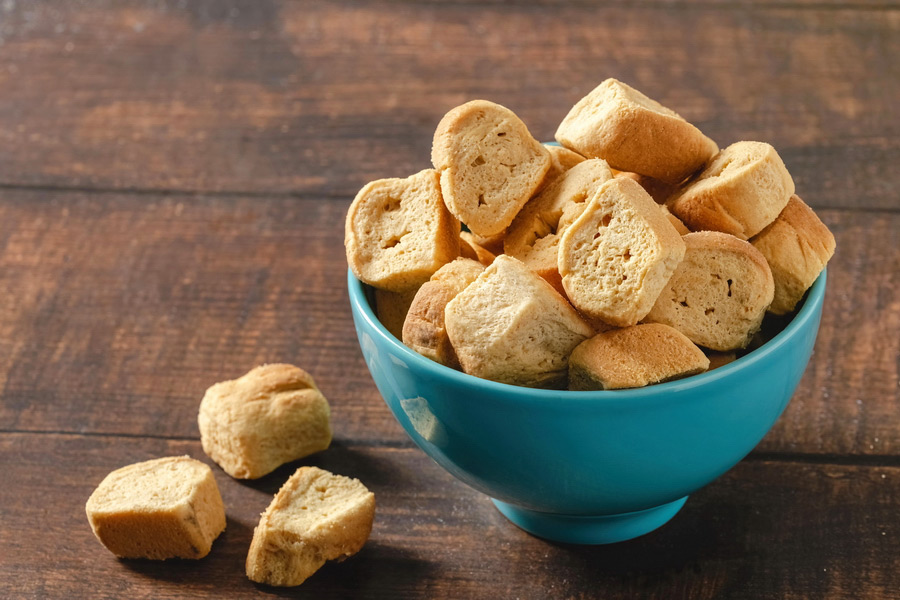
Konya, a spiritual hub of Turkey, is also the homeland of Konya etli ekmek, a type of thin meat Turkish pizza, and bamya çorbası, an okra soup traditionally served at weddings. Konya’s cuisines are closely tied to the simplicity and hospitality of Sufi Mevlevi traditions.
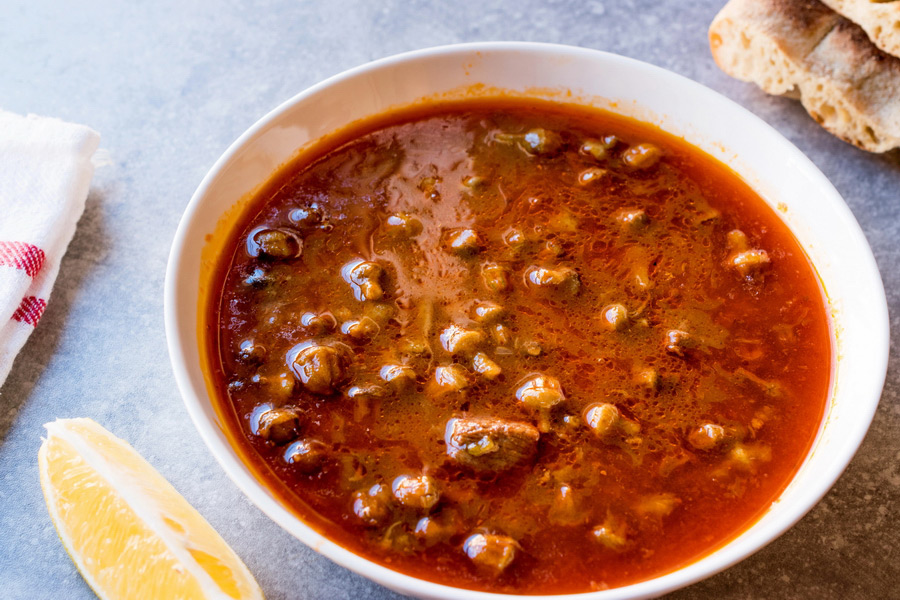
Cappadocia, particularly around Nevşehir and Ürgüp, caters to regional varieties like testi kebabi (lamb or vegetables stewed in a sealed clay pot, broken open tableside) and dolaz, a sweet flour treat typically served with grape molasses.
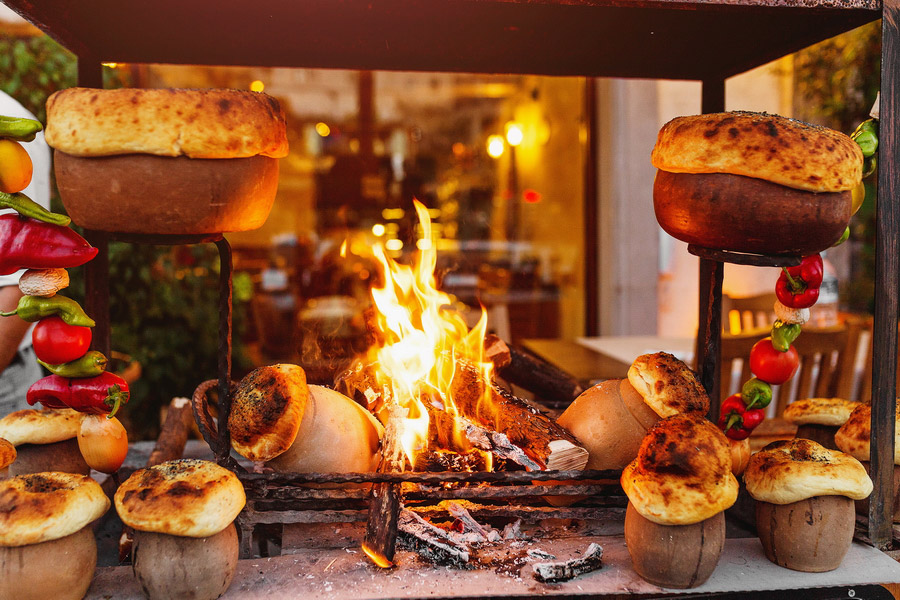
Kayseri is well-known across Turkey for its mantı, tiny dumplings filled with spiced meat filling, served with yoghurt and garlic butter. The city is also a centre of cured meats, especially pastırma (air-dried beef with a spicy coating) and sucuk (fermented sausage).
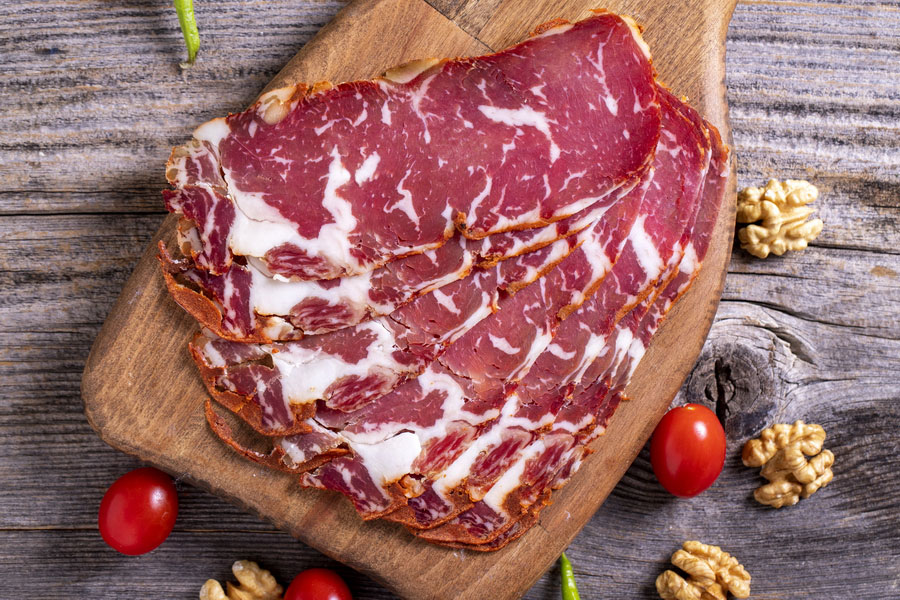
In Eskişehir, gastronomic goodness has Central Anatolian and Balkan backgrounds. Try çibörek, a half-moon fried pastry filled with minced meat brought to the region by the Crimean Tatars. Among its local foods is balaban köfte, grilled meatballs served on bread with tomato sauce and yoghurt.
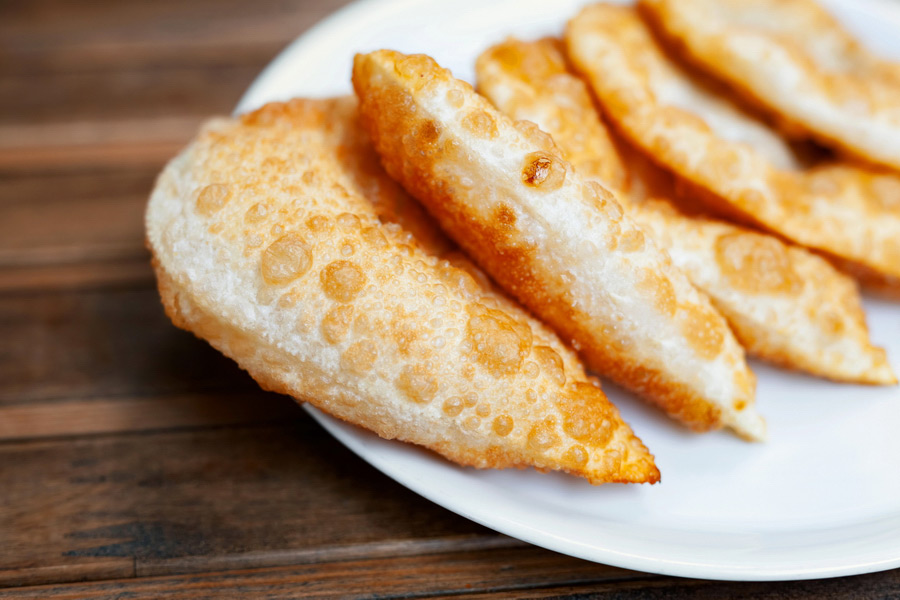
Eastern Anatolian Traditional Meat and Yoghurt Dishes
Eastern Anatolia is shaped by rugged mountains, long winters, and a pastoral lifestyle. These natural conditions have shaped its cuisine, which relies heavily on meat, dairy, grains, and preserved ingredients. Meals are often high in protein and fats and are designed to sustain nomadic and rural communities through harsh weather and long journeys.
Staples comprise lamb, yoghurt, and fresh herbs, with cooking methods often emphasising slow-roasting and stewing. One of the region’s classical dishes is çağ kebabı, a horizontally roasted lamb kebab marinated in onion and salt for around ten hours and cooked slowly over a wood fire.
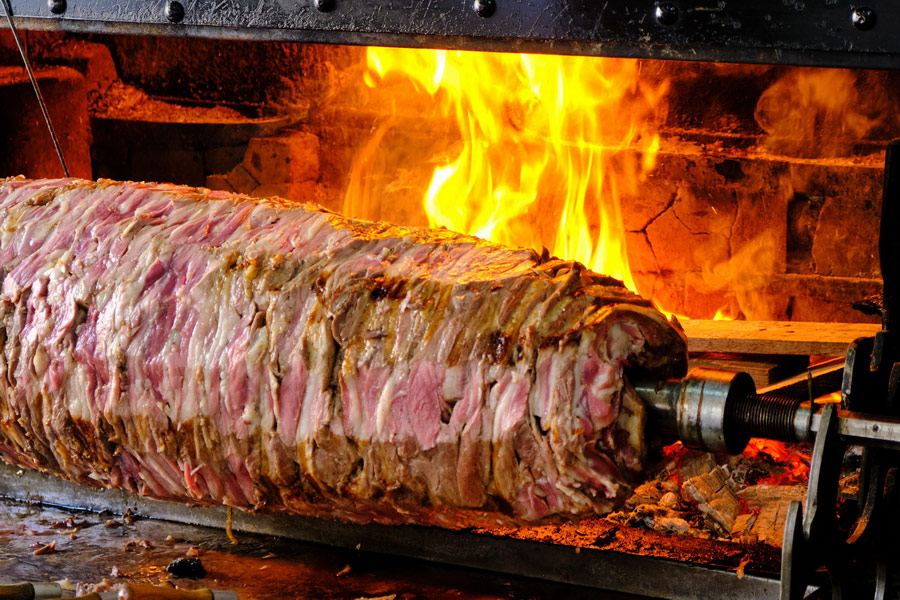
Over the years, this distinctive style of kebab has become a culinary symbol of Erzurum, where masters such as Şakir Aktaş and Kemâl Koç operate prominent restaurants, each claiming lineage from the original creators of the dish. In 2010, the Turkish Patent and Trademark Office officially recognised cağ kebabı with a geographical indication under the name Erzurum Oltu Cağ Kebabı.
Other dishes in the region are buryan kebabı (pit-roasted lamb), yuvarlama çorbası (a yoghurt soup with meat and chickpeas), and Harput köftesi (Harput meatballs), named after the historic town of Harput near Elaziğ.
When visiting Van Province and its stunning lake, be sure to sample Van Kahvaltısı. This breakfast features otlu peynir (herbed cheese), murtuğa (made with butter, flour and scrambled eggs), a cucumber cacık (a Turkish appetiser made with yoghurt, water, and garlic), kavut (roasted wheat flour dessert), and kurut (small, round cheesy balls often used in soups and stews).

Further north in Erzurum, meat is a key ingredient. A sumptuous end to a hearty meal would be kadayıf dolması, a dessert made by wrapping nuts in shredded phyllo dough, deep frying it, and soaking it in syrup. Another speciality is lor dolması, stuffed vine leaves made with curd cheese rather than meat.
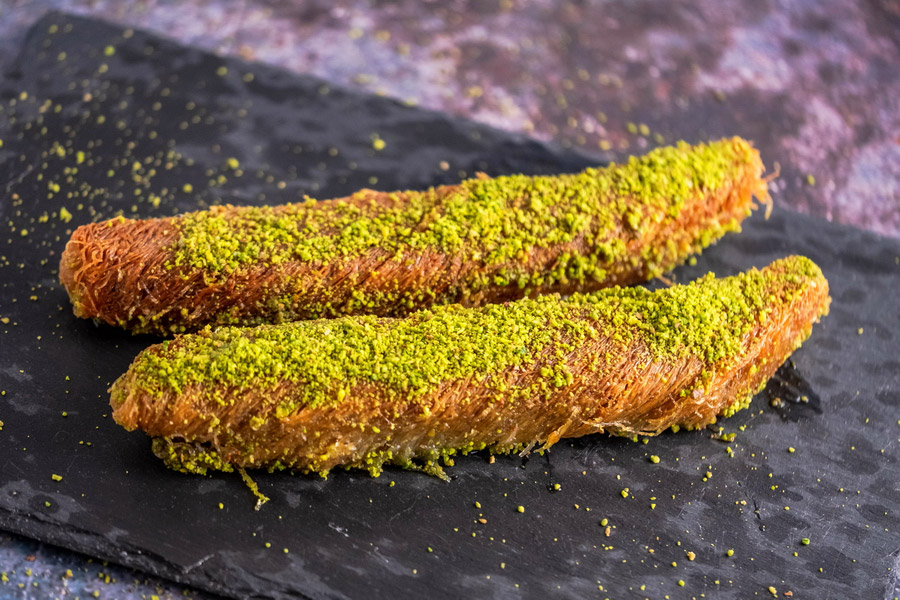
Southeastern Anatolian Cuisine Spicy Dishes
Dishes in Southeastern Anatolia are similar to those in Eastern Anatolia, heavy with meat, tomatoes, and spices. Wheat and vegetables are also common ingredients, along with lentils, rice, and chickpeas. Dairy products and red meat are a routine part of the region's diet. Notable examples include Turkish yalancı dolması (stuffed vine leaves) and biber dolması (stuffed bell peppers), with fillings typically made from a mixture of bulgur or rice, meat, herbs, spices, tomato paste, and black pepper.
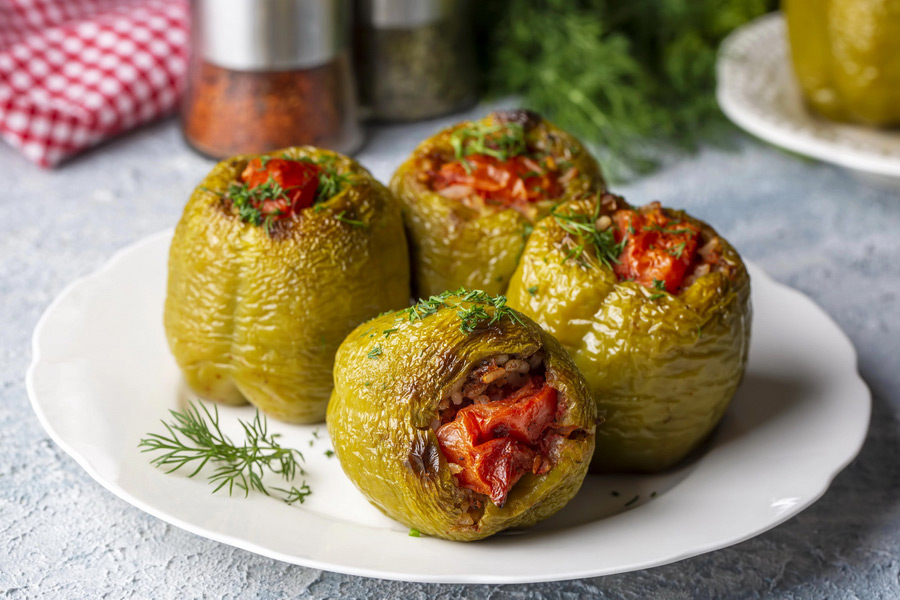
When you travel through this part of Turkey, you will likely explore its distinguished cities: Mardin, Şanlıurfa, and Gaziantep. Each brings something different to the table. So, which foods should you try while visiting?
In Mardin, be sure to taste kaburga dolması (stuffed ribs), icli köfte (fried stuffed meatballs), ikbebet (roasted stuffed meatballs boiled), and genadir, a warming, traditional soup beloved by locals.
Two staples stand out in Şanlıurfa: çiğ köfte, made with spiced raw bulgur and ground meat, and Urfa kebab, a milder, savoury version of the standard Turkish kebab.
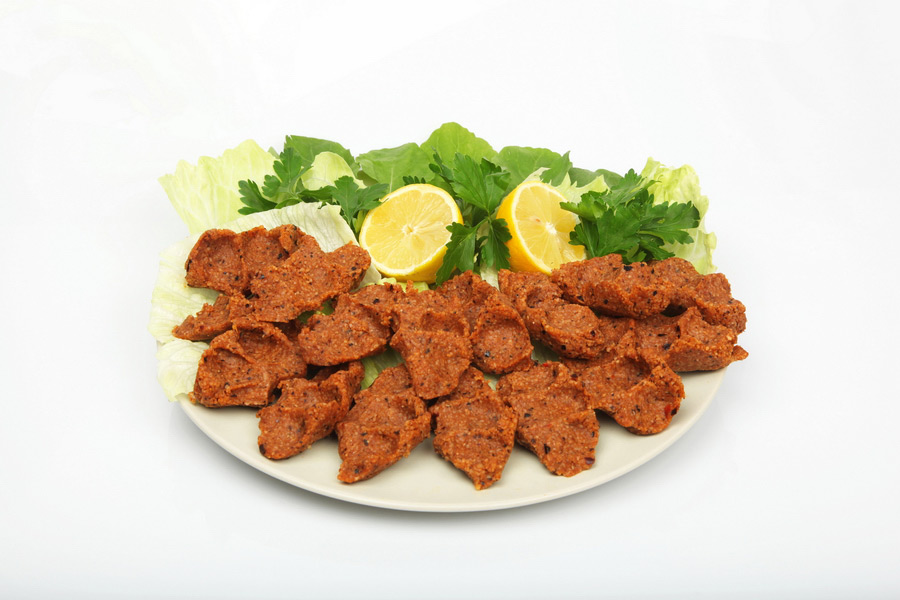
And in Gaziantep, widely regarded as Turkey’s gourmet capital, the flavours become even more intense. Do not miss katmer (a thin pastry filled with pistachios and clotted cream), küşleme (tender lamb fillet), sütlaç (rice pudding), and, of course, the city’s legendary baklava.
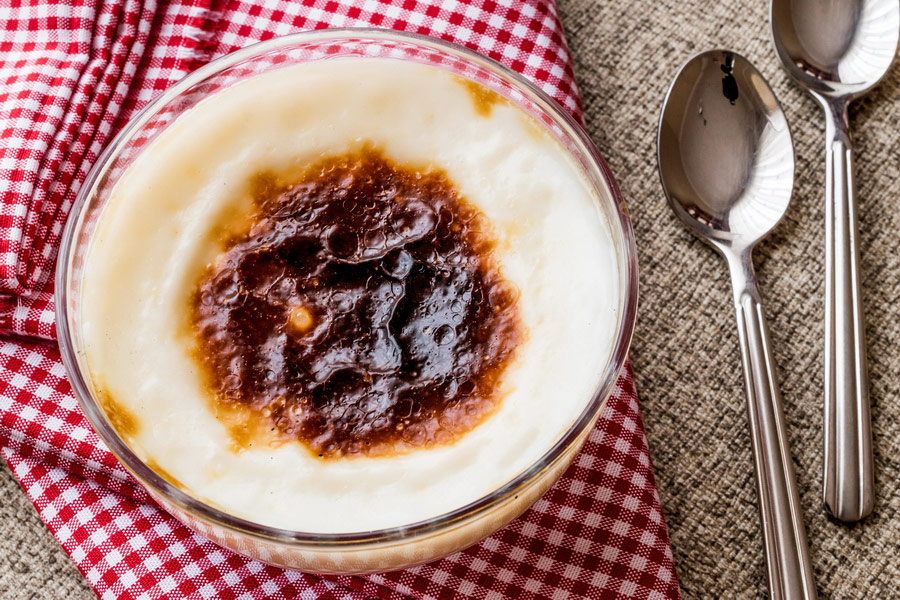
Together, these cities provide an enticing glimpse into the heart of Southeastern Anatolia.
Black Sea Turkish Dishes with Anchovy and Corn
Black Sea cuisine mirrors the region’s lush green landscapes, rainy climate, and coastal abundance. It draws heavily on ingredients such as corn, anchovies (hamsi), collard greens, and dairy. The maritime cuisine is abundant, with over 20 ways to prepare hamsi alone – fried, stewed, baked into pilaf, or even turned into meatball-style croquettes.
When exploring the region, each city promises its local twist.
Samsun, the largest city on the Black Sea coast, is noted for Bafra pidesi, a type of long flatbread with spiced ground meat filling. Kaz pilavi is a dish of rice cooked with goose meat, traditionally served during winter festivals and village gatherings.
Trabzon, situated between the sea and the mountains, is the heartland of anchovy culture. Sample hamsili pilav (anchovy rice), creamy Trabzon tereyağı (butter), and Trabzon ekmeği, a dense, round village bread baked in stone ovens. Kuymak, or muhlama, is a high-calorie breakfast of cornmeal, butter, and melted local cheese.
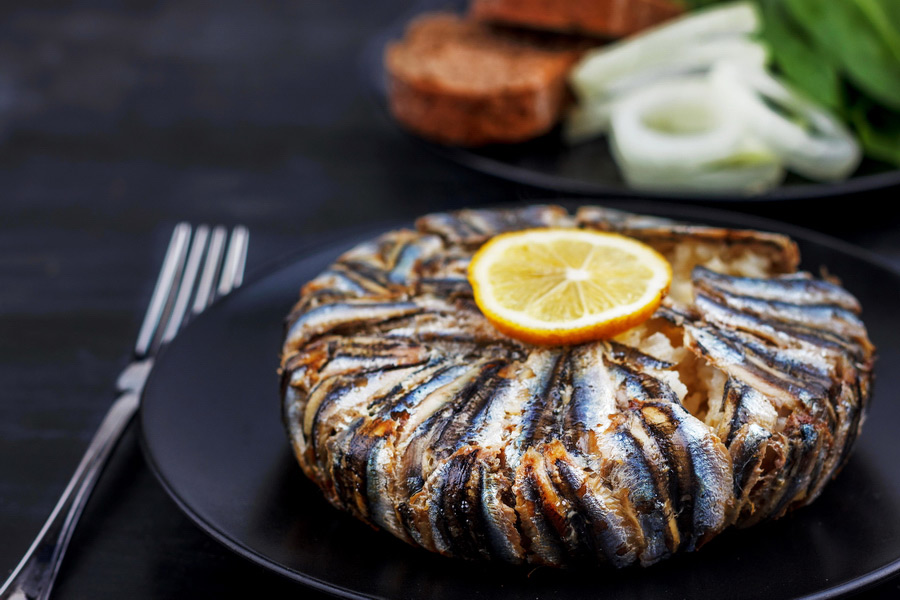
Although more inland, Safranbolu brings a unique flavour to the region's cuisine with its Ottoman-era culinary lineage. The town boasts peruhi, handmade dumplings like Turkish mantı, and safranlı zerde, a saffron-infused rice pudding. Of course, Safranbolu is also globally recognised for its Turkish delight, lokum (Turkish Delight), and especially saffron varieties.
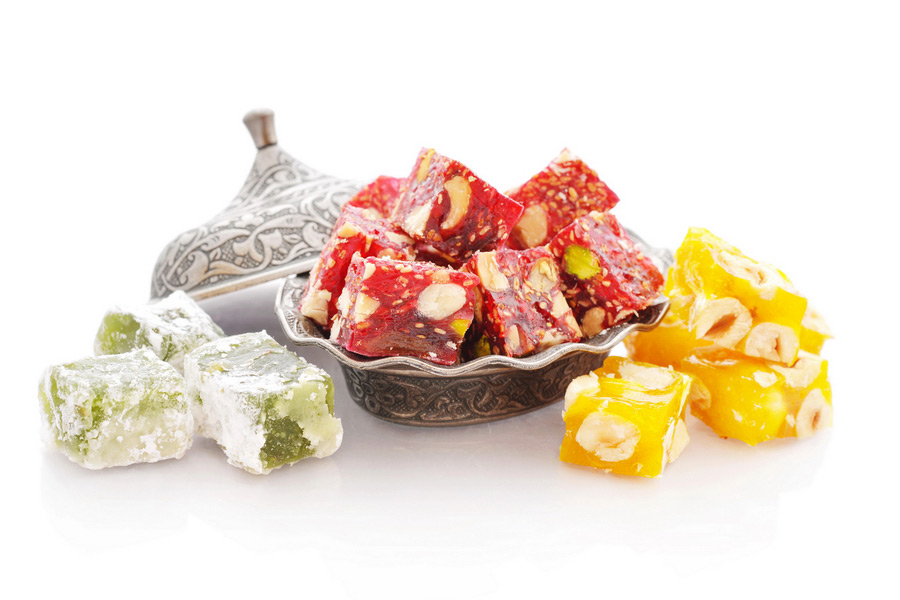
Sinop is situated on a scenic cape that juts into the sea. The homemade dish and commonly served at local restaurants is Sinop mantısı. These are larger, flatter dumplings topped with garlic yoghurt and butter sauce. Another local treat is nokul, a sweet or savoury pastry roll that's a favourite in local bakeries.

